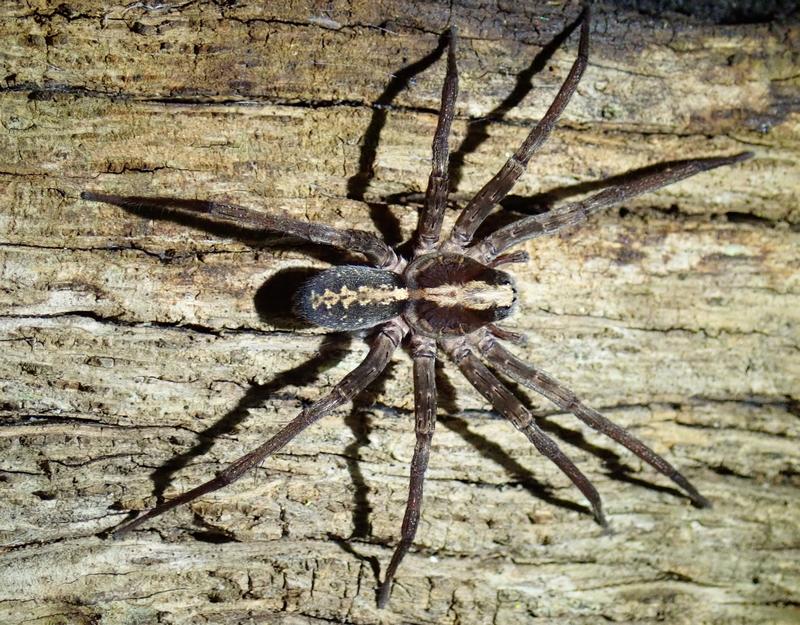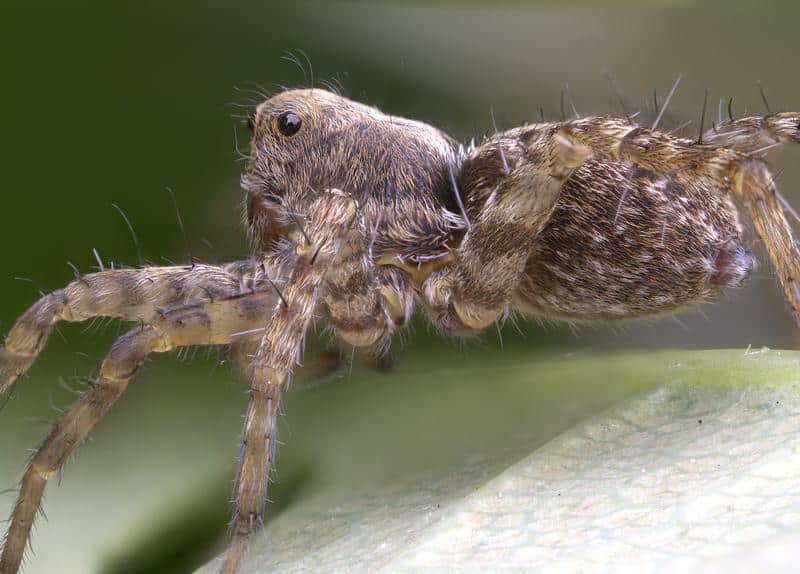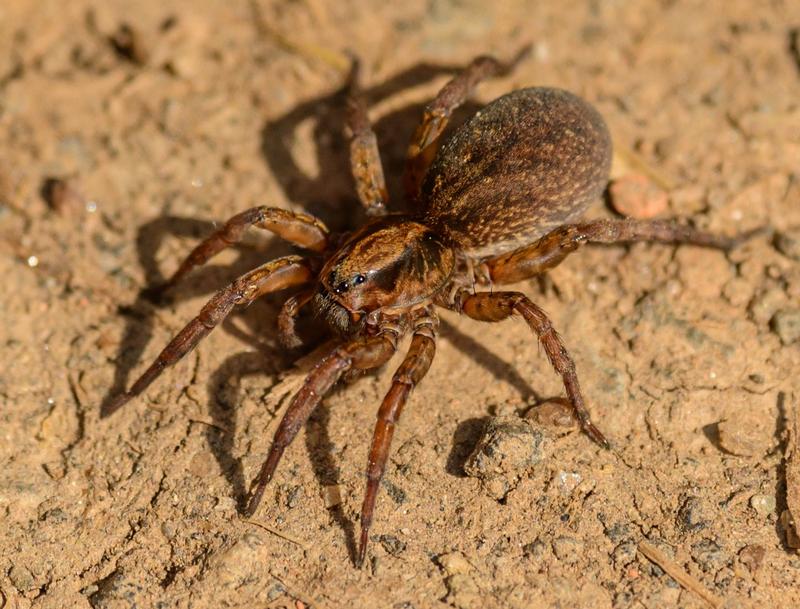Dog Bit by Wolf Spider: How to Treat Wolf Spider Bite on Dog
Dog bit by wolf spider? Stay calm! While wolf spider bites on dogs will cause discomfort, they’re rarely life-threatening. Still, you need to take immediate action. In this article, we’ll tell you exactly how to treat a dog bitten by a wolf spider, the symptoms to look for, and the command you’ll need to prevent future issues.
Next, we’ll cover other important topics like are wolf spiders poisonous to dogs, can a wolf spider kill a dog that’s healthy, what to do if your dog ate a wolf spider, and what wolf spiders look like so you can be sure of what you’re dealing with. Finally, we’ll instruct you on how to get rid of wolf spiders permanently. Keep reading!
Dog Bit by Wolf Spider

Wolf spider bites on dogs are generally non-lethal. While the bite can cause discomfort and mild symptoms like swelling, redness, and itching, severe reactions are uncommon. If you have a dog bit by a wolf spider, watch them carefully and consult a vet if symptoms persist or worsen.
Wolf Spider Bite on Dog
Wolf spider bites on dogs can look like a small red welt on your dog’s skin. These spiders are not typically aggressive, but they will bite if they feel threatened or cornered. Bites occur when a dog accidentally steps on or disturbs the spider. While the bite can be painful and uncomfortable, it’s not usually serious.
Wolf Spider Bite Dog Symptoms
If you have a dog bitten by a wolf spider, you might notice the following symptoms:
- Localized Redness and Swelling: A bite mark can cause a small area of redness and swelling. This is the most common symptom of a spider bite.
- Itching or Rash: Your dog might itch at the bite site, and a rash could develop around the area.
- Apparent Pain: If your dog is excessively licking or biting at one area, it could be a sign that the bite is causing discomfort.
- Behavioral Changes: Changes in behavior, such as restlessness or agitation, might indicate that your dog is in distress.
If these symptoms persist or you notice severe reactions like difficulty breathing, excessive drooling, or loss of consciousness, contact a veterinarian immediately.
Training the “Leave It” Command
Teaching your dog the “Leave It” command can be helpful in preventing future encounters with spiders and other potentially harmful creatures. Here’s a basic way to teach this command:
- Start with a Treat: Hold a treat in your closed hand and let your dog sniff it.
- Say the Command: As your dog sniffs and tries to get the treat, firmly say, “Leave it.”
- Wait for the Reaction: Wait until your dog stops trying to get the treat. They may back away or sit down.
- Reward Your Dog: Once they have stopped, give them a treat from your other hand and praise them.
- Repeat: Repeat this exercise several times until your dog understands that “Leave it” means they should back away.
These steps will get your dog to stay away from wolf spiders, but it’s important to remember that the underlying behavioral issues (prey drive, curiosity, overexcitement, etc.) that were causing all of this to begin with will still be present. And until you address those, any positive changes you see are only going to be temporary.
“Well, how do I make these changes last?”
By getting your dog to truly choose to follow your direction, that’s how. I tried many times to write out how you can do that before deciding it made more sense to just link you to the free video series that explains it better than I’d ever be able to.
The series is by a man named Dan who is one of the world’s leading dog obedience trainers. In it, he teaches you how to put an end to things like your dog eating wolf spiders and all other misbehavior using his fast and easy-to-follow methods.
In the first video, Dan will reveal to you why the two most common methods of dog training only doom you to failure. You can watch the video now by clicking here. Follow the proven system he’ll show you in his series and you’ll never have to spend another second worrying about your dog bothering wolf spiders ever again!
Are Wolf Spiders Poisonous to Dogs?

Wolf spiders are not poisonous to dogs, though they are venomous. Most often, a bite from a wolf spider may cause temporary discomfort and localized swelling, but it’s unlikely to be life-threatening to your pet.
That said, every dog can react differently and individual allergic reactions are possible, although rare. It’s always important to keep an eye on your dog’s behavior and symptoms after a spider bite and consult with a vet as needed.
Are Wolf Spiders Dangerous to Dogs?
Wolf spiders are usually not dangerous to dogs despite their somewhat intimidating appearance. These spiders are more likely to run away than bite. However, if they feel cornered or threatened, they may bite in self-defense.
The venom from a wolf spider is designed to paralyze small insects, not large animals or humans, so the bite’s main impact is typically local pain and swelling.
Although wolf spider bites are not usually dangerous, they can be quite uncomfortable for your pet. A bitten dog may experience redness, swelling, and irritation around the bite site, and in some cases, a mild fever. It’s also possible for the bite area to become infected if not properly cleaned and cared for.
Can a Wolf Spider Kill a Dog?
A wolf spider’s bite is highly unlikely to be fatal to a dog. Most canine reactions to such a bite are mild, mainly involving localized pain and swelling. However, in rare cases, a dog may have an allergic reaction to the bite.
Signs of an allergic reaction can include hives, difficulty breathing, weakness, vomiting, and excessive drooling. If you observe any of these symptoms in your dog after a bite, you should seek veterinary attention immediately.
Preventing Spider Bites in Dogs
The best way to protect your dog from wolf spiders or any other potential hazards is prevention. Keeping your home and yard clean and free of clutter can help deter spiders and other pests. When walking your dog, keep them on a leash and steer clear of areas where spiders might be, like woodpiles or dense undergrowth.
Training your dog to avoid spiders and bugs is also a very good idea. Teach the “Leave It” command which can prevent your dog from getting too close to a potential threat. Learn how to do it in the first section.
While wolf spiders are not typically dangerous to dogs, it’s always best to err on the side of caution. Monitor your dog closely for any adverse reactions following a bite, and consult with a vet if symptoms persist or worsen. Ultimately, proper prevention strategies and obedience training are your best tools for protecting your dog from spider bites.
You should get this problem handled now as it will also keep your dog safe during other future encounters. That means you won’t have to worry about questions like are jumping spiders poisonous to dogs, what to do when a grass spider bites a dog, are orb weaver spiders poisonous to dogs, and are yellow garden spiders poisonous to dogs.
My Dog Ate a Wolf Spider

If your dog ate a wolf spider, there’s typically no cause for alarm. While wolf spiders are venomous, the venom usually only causes harm if injected into the body through a bite, not if swallowed. Your dog may experience mild gastrointestinal upset, but serious symptoms are unlikely.
However, it’s always a good idea to observe your dog for any abnormal behavior or symptoms, and consult a vet if you’re concerned.
Dog Ate Wolf Spider: What to Expect
After eating a wolf spider, your dog might exhibit some signs of discomfort. These could include drooling, loss of appetite, or a mild upset stomach. This is more likely due to the irritation caused by the spider’s hairy body and spiky legs, rather than the spider’s venom.
Some dogs might also paw at their mouth or appear to have difficulty swallowing if the spider caused discomfort in the throat.
It’s important to keep an eye on your dog for a few hours following the incident. Monitor for signs of excessive drooling, repeated vomiting, loss of appetite, lethargy, or any other unusual behavior. If your dog shows any signs of distress, it’s best to seek veterinary advice immediately.
Wolf Spiders and Dogs: A Common Curiosity
It’s not uncommon for dogs to be intrigued by spiders and other small, fast-moving creatures. The wolf spider’s quick, erratic movements can be particularly enticing to a dog’s natural hunting instincts. However, wolf spiders prefer to run and hide rather than confront a potential threat, and they will only bite when cornered or handled.
While a wolf spider’s bite can cause temporary discomfort, it’s generally not dangerous to dogs. And if your dog eats the spider, it’s unlikely to cause any significant harm, although it may result in minor discomfort or digestive upset.
Preventing Your Dog Eating Wolf Spiders
The best way to prevent your dog eating wolf spiders is through training and management. Teach your dog the “Leave It” command, and use it whenever they show interest in a spider or any other potential hazard. Go back to the first section to learn how. Keeping your home and yard free of clutter can also help reduce the number of places where spiders can hide.
In most cases, if your dog eats a wolf spider, they’ll be just fine. Nevertheless, it’s always best to monitor your pet closely for any unusual symptoms, and when in doubt, consult with a veterinarian. The key to preventing these incidents is a combination of thorough pest control and patient, consistent training.
What Do Wolf Spiders Look Like?

Wolf spiders are typically large, hairy spiders with a distinctive physical appearance. They can be identified by their large, robust body, hairy legs, and eight eyes arranged in three rows. Wolf spiders are often brown, gray, or black and some species have patterned markings on their bodies.
How Big Do Wolf Spiders Get?
Wolf spiders are among the larger species of spiders, and their size can vary greatly depending on the specific species and sex. The body length of wolf spiders ranges from 0.4 to 1.38 inches (10 to 35 mm). If you add in the legs, the total length can be up to 4 inches (10 cm). Female wolf spiders are generally larger than males.
Wolf Spider Identification
Wolf spiders have a unique set of characteristics that set them apart from other spiders. They are robust and agile hunters with excellent eyesight. They live mostly solitary lives and hunt alone.
They have eight eyes arranged in three rows: the bottom row consists of four small eyes, the middle row two very large eyes, and the top row two medium-sized eyes. This eye arrangement is unique to wolf spiders.
Most species are dark brown, and they carry their egg sacs attached to their spinnerets, a behavior that is not common in many other species of spiders. After hatching, the spiderlings climb onto their mother’s back and stay there until they are fully developed, this is also a unique characteristic of wolf spiders.
Are Wolf Spiders Aggressive?
While wolf spiders can appear intimidating due to their large size, they are generally not aggressive toward humans or pets and prefer to retreat when threatened. They will bite only if provoked or handled roughly, and their venom is not dangerous to humans or pets, although it may cause a reaction in some individuals.
What Are Wolf Spiders?
Wolf spiders are members of the family Lycosidae, a large and widespread group that is found throughout the world. They are ground-dwelling spiders that do not spin webs to catch prey. Instead, they rely on their keen eyesight and agility to hunt, much like wolves (hence their name).
They can be found in a wide range of habitats, including forests, grasslands, suburban gardens, and homes.
Wolf spiders are distinctive, interesting creatures. While their appearance may be daunting to some, they pose little threat and generally prefer to avoid confrontation. Recognizing them can help you understand their behaviors better and coexist with these intriguing arachnids. Learn to control your dog around spiders in the first section.
How to Get Rid of Wolf Spiders

To get rid of wolf spiders, you need to maintain a clean environment, seal off entry points, use natural deterrents such as essential oils, and consider utilizing sticky traps. Remember that these spiders can be beneficial for controlling pests, but if they’re becoming a nuisance, the following methods can be useful.
- Clean Environment: Maintaining a clean and clutter-free environment can discourage wolf spiders from making themselves at home. These spiders thrive in messy environments, as it gives them plenty of hiding spots. Regularly vacuuming and reducing clutter can make your home less inviting for wolf spiders.
- Seal Entry Points: Like many pests, wolf spiders can enter your home through cracks and gaps in walls, doors, and windows. Inspect your home for potential entry points and seal them off using caulk or weather-stripping. This will not only deter wolf spiders but also other pests.
- Natural Deterrents: Certain essential oils like peppermint can serve as natural deterrents to wolf spiders. You just mix a few drops of the oil with water in a spray bottle and spray it around your home, especially in areas where you’ve noticed spider activity.
- Sticky Traps: Sticky traps can be a useful tool for controlling wolf spider populations. These traps can be placed around your home in areas where spiders are frequently seen. When a spider walks across the trap, it becomes stuck and unable to escape.
Getting rid of wolf spiders involves keeping your home clean, sealing off entry points, using natural deterrents, and setting up sticky traps. Remember, however, that wolf spiders can be beneficial for controlling other pests. If you’re still having trouble with wolf spiders after trying these methods, you may want to consider contacting a pest control professional.
Learn how to ensure your dog behaves around them (and other spiders) by going back to the first section now.
I’m sure you’re ready to never have to think about any issues between wolf spiders and dogs ever again, so I’ll let you get started. Good luck with everything, and thanks for reading our article “Dog Bit by Wolf Spider: How to Treat Wolf Spider Bite on Dog.”





